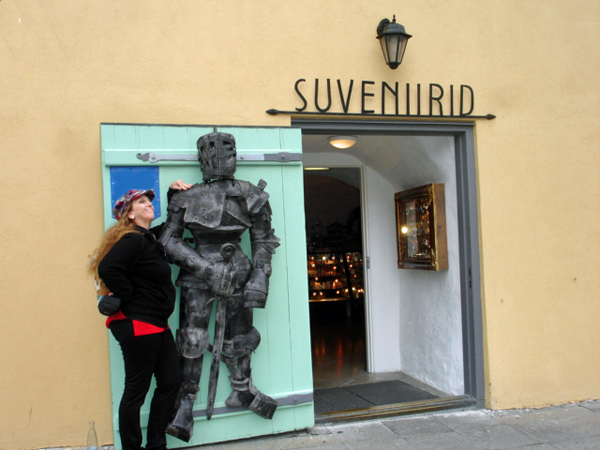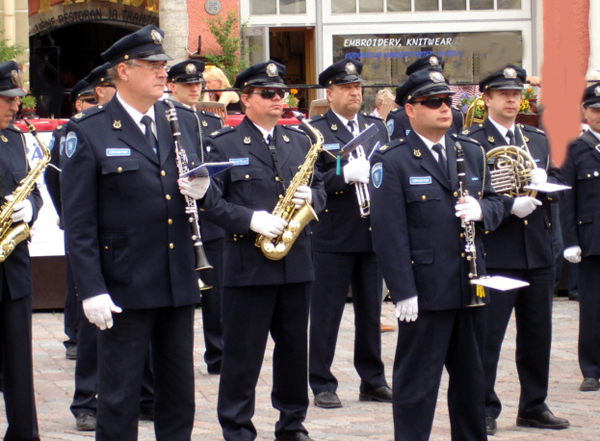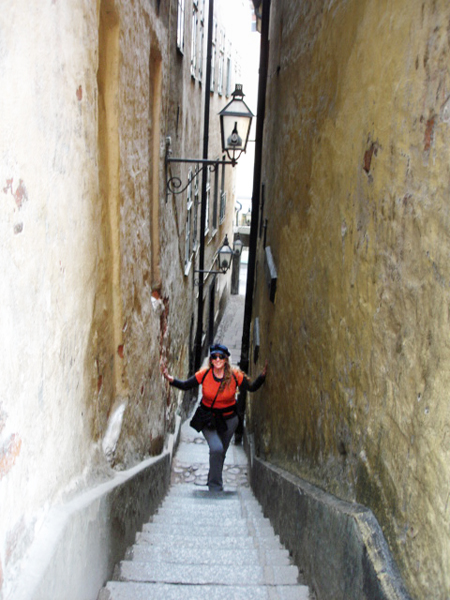Karen Duquette in Tallinn, Estonia
|
|
Tallinn is the capital and most populous city of Estonia. Tallinn is situated on a bay in north Estonia, on the shore of the Gulf of Finland of the Baltic Sea. Tallinn is the main governmental, financial, industrial, and cultural centre of Estonia. It is located 187 km (116 miles) northwest of the country's second largest city, Tartu, and only 80 km (50 miles) south of Helsinki, Finland, also 320 km (200 miles) west of Saint Petersburg, Russia, and 380 km (240 miles) east of Stockholm, Sweden. From the 13th century until the first half of the 20th century, Tallinn was known in most of the world by variants of its other historical name Reval.The earliest evidence of human population in the area dates back nearly 5,000 years. The medieval indigenous population of what is now Tallinn and north Estonia was one of the last "pagan" civilizations in Europe to adopt Christianity following the Papal-sanctioned Livonian Crusade in the 13th century. The first recorded claim over the place was laid by Denmark after a successful raid in 1219 led by King Valdemar II, followed by a period of alternating Scandinavian and Teutonic rulers. Due to the strategic location by the sea, its medieval port became a significant trade hub, especially in the 14–16th centuries, when Tallinn grew in importance as the northernmost member city of the Hanseatic League. Tallinn Old Town is one of the best-preserved medieval cities in Europe and is listed as a UNESCO World Heritage Site.Tallinn has the highest number of startup companies per person among all capitals and larger cities in Europe and is the birthplace of many international high-technology companies, including Skype and Wise. The city is home to the headquarters of the European Union's IT agency, and to the NATO Cyber Defense Centre of Excellence. In 2007, Tallinn was listed among the top-10 digital cities in the world, and in 2022, Tallinn was listed among the top-10 "medium-sized European cities of the future".Above quote is from From Wikipedia, the free encyclopedia |
|
 |
|
 |
|
After disembarking the ship, it was time for Monica Ekedahl, Bitte Svensson and Karen Duquette to explore Tallinn. |
|
Below: A cute pedal car took tourist around the area, or they can ride the train - each most likely for a fee. |
|
Below: The Swedish Flag |
Below: Bitte Svensson and Monica Ekedahl |
Below: Unique designs everywhere |
|
| |
|
Below: A band in the main square. |
|
 |
|
Below: Time to walk the streets of Tallinn and enjoy the sights. |
|
Below: Since Karen Duquette and Monica Ekedahl are both line dancers, they loved seeing the car shown below. They have heard about the line dance events trying to form the longest single line of dancers, but have never been able to participate because none were happening near them. |
|
Below: The famous Rock of Tondi - in Tallinn, Estonia. The Rock of Tondi has been in existence since the prehistory. On the Rock you can barely see drawings made by Estonian Neanderthals. The Rock of Tondi has always been a strategic point. It has been conquered and reconquered multiple times .The name stuck and people started visiting the stone as a joke, making it more and more famous. Today, the stone has a website and can be found on many travel sites. |
|
Below: Remembrance for Voldemar Panso (30 November 1920 Tomsk, Russia – 27 December 1977 Tallinn) was Estonian stage director, actor and theatrical teacher. |
|
Below: Karen Duquette in a narrow walkway with lot of stairs |
|
 |
|
Below: Cruise ship alley |
|

 Continue on to page 2 of
Continue on to page 2 of